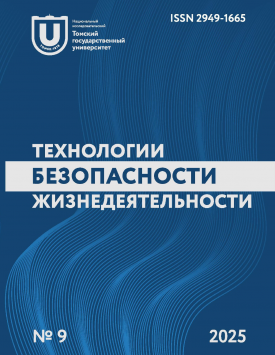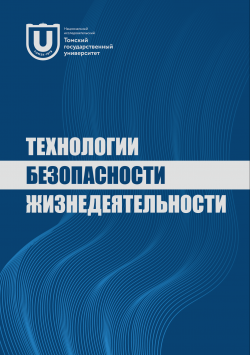The text is typed in Times New Roman font, for the main text - the size of the pin is 12, the line spacing is single, for the list of sources - the size of the pin is 10, the line spacing is single. Fields (all) - 2 cm, paragraph indentation - 0.5 cm. When using additional fonts, they should be submitted to the editor in the author's electronic folder. Article pages must be numbered. The numbering is continuous, from the 1st page, bottom center.
The maximum article size is 12 pages.
The article consists of the following blocks: obrazec_bzhd.docx
1. Header block in Russian.
2. Header block in English.
3. Main text of the article.
4. List of sources.
5. About authors.
1. The header block in Russian includes:
1) number according to the Universal Decimal Classification (UDC),
2) title of the article,
3) name, patronymic, surname of the author/authors,
4) author/author affiliation (organization, city),
5) e-mail address of the author/authors,
6) Open Researcher and Contributor ID (abbreviated as ORCID) (if any),
7) a brief abstract of the article (no more than 500 characters, including spaces),
8) keywords (5-10),
9) gratitude (including links to grants).
2. The header block in English contains the same components as in Russian, with two differences::
1) UDC is not specified;
2) an extended annotation is given (2500-3000 characters with spaces).
Important: the extended annotation should be consistently and logically structured in accordance with the norms for the presentation of scientific results. It should clearly indicate: the problem solved by the author (purpose of the article); research material and methods; conclusions reached or proved by the author; novelty/personal contribution of the author to the problem. The abstract should reflect the essence of the study.
3. Main text of the article
When presenting the material, it is necessary to adhere to the heading: introduction, purpose of work and current state of the matter, materials and research methods, results, discussion, conclusion. Titles, subheadings are printed in bold in the center, without numbering.
4. The list of sources is located after the text of the article, numbered (starting from the first issue), preceded by the phrase "References" and is drawn up in the order of mention or citation in the text of the article (not in alphabetical order!). Only one source is allowed under one number. If the text repeatedly refers to the same source in the List, it must be mentioned only once (under one number). When describing monographs, the list of literature must indicate the place (city, publishing house) and year of publication, the total number of pages, and for articles - pages. References to unpublished works are not allowed.
5. Information about the authors: after the References, information about the author is indicated in Russian and English: 1) surname, name, patronymic, 2) academic degree, 3) position and place of work, 4) city, country, 5) email address, 6) ORCID and other international identification numbers of the author.
If there are several authors, information on the contribution of each of them is also indicated, information on the absence or presence of a conflict of interest is given and details of such a conflict, if any.
Design of individual elements
References to the sources used are given after the quotation in square brackets with the serial number [1]. Be sure to specify the DOI of all sources that have a DOI!
Separately, authors should provide information in English, i.e. REFERENCES: (under the same numbers as in the reference list).
Illustrations (figures, tables, graphs, diagrams, etc.) are additionally provided in separate files saved in the program in which they were prepared. Artwork is pasted into text as an object or as a metafile to allow editing. All drawings are published in black and white, full-color illustrations will be available only in the electronic version of the article. Under the drawings, a signature is necessarily given with the number: "Fig. 1, "" Fig. 2 "in Russian and English" Fig. 1», «Fig. 2».
Tables must be formatted using Word, not by inserting an image. Above the tables is the title: "Table 1. Table name. " If there is only one table in the article, then the numbering is not put. Avoid shading and shading in table cells. Figures and tables must be mentioned in the main text of the article.
Formulas are typed using the Microsoft Equation editor, arranged in the center of the page, numbered (on the right edge of the page in parentheses) and have links in the text of the article. You cannot use the new formula editor built into Word! Formulas must use common font and character size settings.

